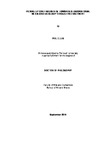PICKING UP (ON) FRAGMENTS: TOWARDS A LABORATORIAL MEDIA ARCHAEOLOGY THROUGH REENACTMENT
| dc.contributor.supervisor | Punt, Michael | |
| dc.contributor.author | Ellis, Phil | |
| dc.contributor.other | Faculty of Arts, Humanities and Business | en_US |
| dc.date.accessioned | 2017-03-09T16:36:15Z | |
| dc.date.issued | 2017 | |
| dc.identifier | 942860 | en_US |
| dc.identifier.uri | http://hdl.handle.net/10026.1/8603 | |
| dc.description.abstract |
This thesis recognises the incompleteness of early television history, specifically as it is articulated in media archeological explorations. Through the process of reenactment, a series of tropes, conceits and insights are suggested which oblige us to reappraise the ontology of television. These insights are not by imitation but by a multiplicity of readings in the viewing of a historical act in the present day through a laboratorial media archaeological arts practice. The thesis interrogates a perceived gap in media archaeology’s body of knowledge through creative, playful and experimental practice borne of archival and historical research, developed from the proposition that both contemporary media archaeology and television historiography do not concentrate on how television is and can be used, only on how it has been used. The practical elements of the thesis focus on one of the formative moments, John Logie Baird’s first television drama (in collaboration with the BBC): The Man with the Flower in his Mouth. The thesis draws upon Media Studies and the discipline of Media Archaeology which both suggest that historical fragments have stable readings and meanings, recognising that both miss the crucial aspect of artistic license, playfulness, and that a laboratorial media archaeological approach, aligned to a considered reenactment process can create a televisual arts practice to tease out the hidden and forgotten. This activated historical account through reenactment keeps the theatrical, the cinematic and the teleportation in a simultaneous presence, digging into the past to address present and future television through this televisual arts practice. | en_US |
| dc.language.iso | en | |
| dc.publisher | University of Plymouth | |
| dc.subject | Media Archaeology | en_US |
| dc.subject | Early Television | |
| dc.subject | Television History | |
| dc.subject | Television Practice | |
| dc.subject | Reenactment | |
| dc.subject | Laboratorial media archaeological arts practice | |
| dc.subject | Archive | |
| dc.subject | John Logie Baird | |
| dc.subject.classification | PhD | en_US |
| dc.title | PICKING UP (ON) FRAGMENTS: TOWARDS A LABORATORIAL MEDIA ARCHAEOLOGY THROUGH REENACTMENT | en_US |
| dc.type | Thesis | |
| plymouth.version | publishable | en_US |
| dc.identifier.doi | http://dx.doi.org/10.24382/610 | |
| dc.rights.embargodate | 2018-03-09T16:36:15Z | |
| dc.rights.embargoperiod | 12 months | en_US |
| dc.type.qualification | Doctorate | en_US |
| rioxxterms.version | NA |
Files in this item
This item appears in the following Collection(s)
-
01 Research Theses Main Collection
Research Theses Main


